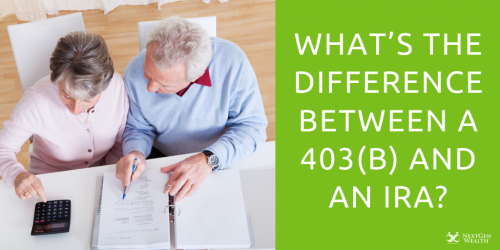What’s the Difference Between a 403(b) and an IRA?
No matter how old you are, it’s never too early to start planning for retirement. While you should start saving as soon as possible, one of the best ways to build a substantial nest egg is to work somewhere that offers employer contributions, like a 401(k). However, for those working in nonprofit organizations, a 401(k) plan is not usually an option. 
Fortunately, many of these entities may offer what’s called a 403(b) retirement account. In this article, we’ll discuss the finer points of a 403(b), as well as compare it to an alternative, the individual retirement account (IRA). Here are the details you need to know.
Breaking Down the Differences Between a 403(b) and an IRA
To help you understand how both of these plans work (and differ), we’re going to break them down in a variety of categories. These will include:
- Qualifications
- Tax Benefits
- Contribution Limits
- Income Restrictions
- Withdrawals
- FAQs About 403(b) Plans and IRAs
By the end of the article, you should have more than enough information to make the right decision for your retirement planning.
Qualifications for 403(b) Plans and IRAs
First and foremost, you can only qualify for a 403(b) through an employer. The plan works similarly to a 401(k) in that you can’t open an account by yourself. By comparison, an IRA is easy to open, and most institutions allow you to do so within minutes.
There are two types of IRAs, which we’ll discuss later on in the article. First are traditional IRAs, as well as Roth IRAs. The primary difference between the two is how they are taxed, which can be beneficial at different stages of your career.
That being said, not all employers can offer a 403(b). In some cases, the business may be able to provide both a 403(b) and a 401(k). Before we go further, we should note that the names of these plans are based on the section of the tax code to which they refer.
So, even though they have similar functions, they are treated differently by the IRS. Sometimes a 403(b) is better than a 401(k), and vice versa.
Businesses that qualify for a 403(b) plan must be one of the following: a nonprofit organization, an educational institution (i.e., a school), a government agency, or a religious entity. Again, not all of these employers will offer a 403(b), and some of them might provide multiple plans to their employees.
Each organization will have its own specifications for qualifying for this plan, so you’ll need to talk with your employer. However, the primary purpose of a 403(b) plan is to allow employees to contribute earnings toward retirement.
Like a 401(k), most employers will offer some level of matching, to a certain point. For example, a Simple IRA usually maxes out at three percent of an employee’s income. Not all organizations do contribution matching; however, putting money away in a 403(b) is probably still a smart move.
Bottom Line: IRAs are set up independently, while a 403(b) can only come from an employer.
Tax Benefits
With both a traditional IRA and a 403(b) plan, your contributions are tax-deferred. There are two benefits to this kind of arrangement.
First, you get to deduct those deferrals within the tax year you made them. Your modified adjusted gross income (MAGI) will reflect these contributions.
For example, if you made $40,000 in income but put away $10,000 toward a 403(b), your MAGI would be $30,000. Effectively, you avoid paying taxes on the money that goes into your retirement account.
The second benefit is that, assuming you withdraw the money in retirement, you should likely pay fewer taxes on the income anyway. Since you’re no longer working, you’ll hopefully be in a lower tax bracket, so you get to keep more of your nest egg. Again, both traditional IRAs and 403(b) plans operate this way.
Roth IRAs, however, are not tax-deductible. Contributions don’t count against your MAGI, so you have to pay income taxes on them within the same year. On the flip side, though, you don’t have to pay any taxes when withdrawing the money.
So, if you want tax-free income during retirement, a Roth IRA can be highly beneficial. Again, there are pros and cons to both options, so one is not necessarily “better” than the other. In most cases, you’ll want a traditional and/or a Roth IRA on top of your 403(b) plan.
Bottom Line: Contributions reduce your taxes while working, but you do have to pay the taxes when you withdraw the money.
Contribution Limits
If you’re looking for a compelling reason to utilize a 403(b) account, this is it. According to the IRS, individuals can only contribute $6,000 to an IRA annually (2020). That number is cumulative, not $6,000 per account. For those over 50, they can put an additional $1,000 per year as a “catch-up” contribution.
With a 403(b), however, because the payments are taken from your salary directly (called deferrals), you can put away up to $19,500 (in 2020) in a given year. So, assuming that you want to build a more significant nest egg, these plans can help out immensely. Even better, you can put an additional $6,500 if you’re over 50.
What makes 403(b) plans even more enticing is that some of them allow long-term employees to save even more. For workers who have been at the organization for 15 years or more, they can contribute an extra $15,000.
It’s crucial to note that this is a lifetime total, not annual. So, if you put away the 15 grand in a single year, you’ve hit your limit, no matter how long you stay at the company. If your employer does match your contributions, the total allowed by the IRS is $57,000 in 2020.
Finally, it’s also critical to note that, because a 403(b) is similarly structured to a 401(k) and other employer-matching program, the $19,500 (or $26,000 for 50+ old employees) is the total between plans. Just as the $6,000 annual total spans both types of IRAs, you can’t double your deferrals by opening both a 403(b) and a 401(k).
That being said, a 403(b) is different from an IRA, so you can contribute the maximum for both plan types, up to $25,500 or $33,000 if you’re over 50.
Bottom Line: You can contribute a lot more into a 403(b) plan than an IRA, but you can max out your deferrals to both plans each year.
Income Restrictions
Because tax deferment is a powerful tool to reduce your tax burden in a given year, the IRS has specific guidelines regarding who can benefit. Thanks to the Tax Cuts and Jobs Act of 2017, the income restrictions have been relaxed somewhat, but you still have to pay attention.
Comparatively, there are no income restrictions for a 403(b) - you just can’t contribute more to the plan than you earned within a given year. For example, if your salary is $25,000 and you’re over 50, you can’t put the full $25,000 away (unless you’ve been at the company for more than 15 years).
Here is a breakdown of the income restrictions for both traditional and Roth IRAs. With a traditional IRA, your earnings determine how much you can deduct from your MAGI. With a Roth, your income can potentially prevent you from contributing to the account at all. Also, the restrictions for a traditional IRA only kick in if you (or your spouse) have a retirement account at work, like a 403(b) or 401(k).
Traditional IRA Income Limits for 2020
Individual - $65,000 or Less - Full Deduction
Individual - $65,000 to $75,000 - Partial Deduction (consult the IRS for details)
Individual - $75,000 or More - No Deduction
Married Couple - $104,000 or Less - Full Deduction
Married Couple - $104,000 to $124,000 - Partial Deduction
Married Couple - $124,000 or More - No Deduction
Roth IRA Income Limits for 2020
Individual - $124,000 or Less - Full Contribution
Individual - $124,000 to $139,000 - Partial Contribution
Individual - $139,000 or More - No Contribution
Married Couple - $196,000 or Less - Full Contribution
Married Couple - $196,000 to $206,000 - Partial Contribution
Married Couple - $206,000 or More - No Contribution
Bottom Line: 403(b) plans have no income limits for contributions, but IRAs do. If you don’t have a retirement account at work, a traditional IRA doesn’t have any income restrictions.
Withdrawals
Since both a 403(b) plan and an IRA are designed to help you during retirement, the IRS forces you to take that money out. Another stipulation of the SECURE Act changed the minimum age for required minimum distributions (RMDs). Before, it was 70 1/2 years old, and now it’s 72. This is the same for both traditional IRAs and 403(b) plans.
Roth IRAs, however, have no RMDs since you’ve already paid taxes on the contributions. Yet, if you do decide to pass that money onto your children, they have to either withdraw it all within 10 years or roll it over to an individual Roth.
The specific amount of your withdrawals will depend on complicated formulas provided by the IRS. If you don’t take the money out in a given year, you’ll be hit with a 50% penalty. So, even if you don’t need the funds, you’ll have to accept them no matter what.
However, what if you need money before turning 72? The current rule is that you will incur a 10% penalty for early withdrawals until you reach age 59 1/2. So, anytime after 59 ½ and you just pay taxes with no penalty.
For those younger than 59 1/2, there are some specific situations where you don’t incur the penalty. These circumstances can include:
- Permanent Disability
- Purchase of a First Home (for yourself or a child)
- Higher Education Costs
- Medical Bills Exceeding 7.5-percent of your AGI*
- Permanent Layoff at Age 55 or Older
- Substantially Equal Periodic Payments (SEPP Plan)
- *Retirement account funds only cover anything above 7.5-percent
With a SEPP Plan, you’re telling the IRS that you will withdraw the same amount each year for at least five years, whether you need the money or not. This also means you’ll have to pay taxes on those withdrawals. We don’t recommend setting up a SEPP Plan unless you’re sure that it’s what you need.
Alternatively, you can sometimes take a personal loan from a 403(b) plan. You do have to repay the loan with interest and follow the repayment plan to avoid the 10% penalty. The primary benefit of going this route is that you’re paying yourself.
So, even though you’re accruing interest, the fees go back into your retirement account. In some cases, these loans can be useful for investment purposes, but that’s a topic for another article.
With a Roth IRA, you can withdraw any of your contributions at any time without penalty (again, because you already paid the taxes). However, investment earnings and dividends will incur a 10% penaly if you’re not at least 59 1/2. The same hardship rules apply, though, in case you have to withdraw funds early.
Bottom Line: You can take money out of a retirement account after 59 1/2 penalty-free. By 72, the IRS will force you to withdraw funds, which are called RMDs. Roth IRAs have no such terms.
FAQs About 403(b) Plans and IRAs
We’ve covered a lot of the differences between these types of accounts, but here are some additional factors to consider.
Can I rollover a 403(b) to an IRA? What about a 401(k)?
Yes, you can do this, particularly if you’re leaving your employer. Be sure that your new job offers a 401(k) plan, though.
Can I take my 403(b) to a new job?
That depends on a variety of factors. In most cases, an IRA rollover is the best option.
Is a 403(b) better than a 401(k)?
That totally depends. However, 401(k)’s do seem to have better investment options and lower fees as a whole.
Contact NextGen Wealth Today
Retirement planning can be overwhelming if you don’t know what to expect. If you want to maximize both a 403(b) plan and an IRA, contact us to find out how we can help.



